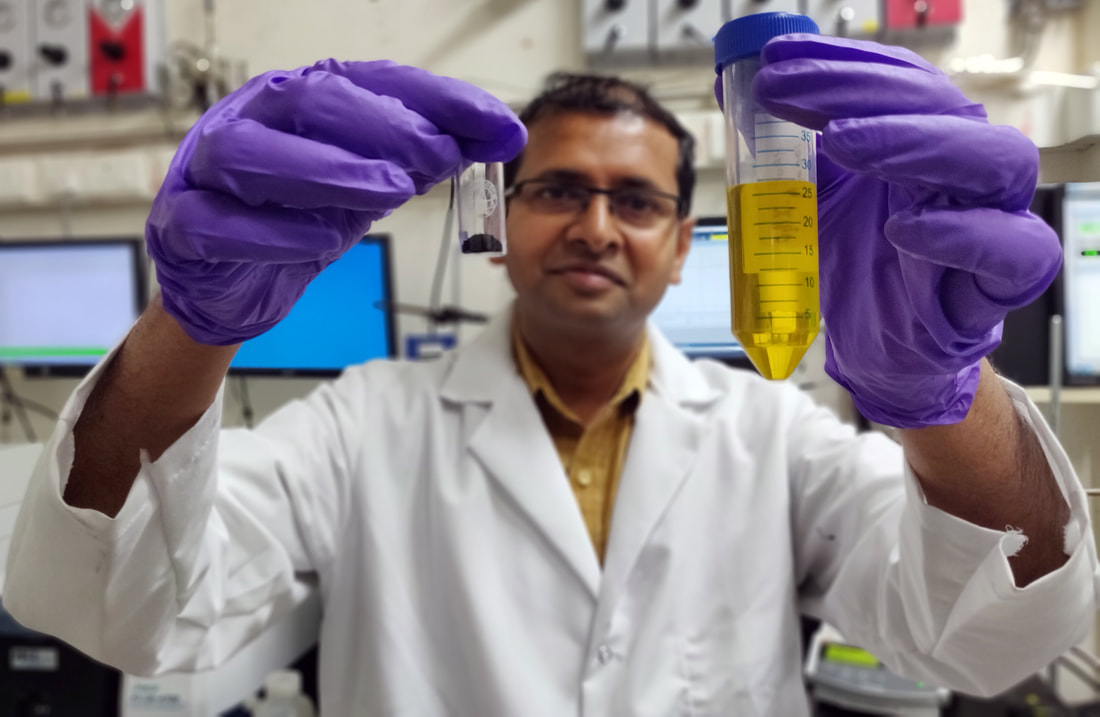|
|
Welcome to Polshettiwar's NanoCat GroupPolshettiwar's Nano-catalysis group is part of Division of Chemical Sciences (DCS) of Tata Institute of Fundamental Research (TIFR), Mumbai.
Global warming poses a significant threat to the planet and all living beings. One of the primary contributors to global warming is the escalating atmospheric CO2 levels, primarily stemming from the combustion of fossil fuels in our everyday lives, including electricity generation, transportation, and industrial activities. To address this challenge, CO2 hydrogenation utilizing green hydrogen emerges as a highly promising process, offering a potential solution to three critical issues: i) the excessive accumulation of CO2, ii) the temporal disparity between solar electricity production and demand, and iii) hydrogen gas storage. Professor Polshettiwar’s group is dedicated to advancing the development of innovative nanomaterials for purposes including catalysis, solar energy capture, and the conversion of CO2 to address the challenges posed by climate change. They have successfully created cutting-edge nanocatalysts through precise morphological control of nanomaterials, particularly dendritic fibrous nanosilica (DFNS). What sets DFNS apart is its remarkable high surface area, achieved through its fibrous structure rather than pore formation, rendering this extensive surface easily accessible (Acc. Chem. Res. 2022, 55, 1395). Our endeavor focuses on achieving this solution in a sustainable manner, breaking down barriers to attain CO2 "net zero" and potentially averting the impending climate catastrophe. Through extensive research, my team has pioneered the solution-phase synthesis of Dendritic Plasmonic Colloidosomes, also known as "black gold," (Chemical Science, 2019, 10, 6694-6603) employing DFNS to control the interparticle distances between gold nanoparticles. This black gold material exhibits exceptional light absorption properties, effectively harnessing the entire visible and near-infrared spectrum of solar radiation. Remarkably, black gold serves as a catalyst, facilitating the conversion of CO2 into fuel at atmospheric pressure and temperature, employing solar energy. Analogous to real trees, our developed black gold acts as an artificial tree, utilizing CO2, sunlight, and water/hydorgen to produce fuel that can power vehicles (ACS Nano, 2023, 17, 4526). This groundbreaking work represents a pioneering effort and a significant step toward the development of "Artificial Trees" capable of capturing and converting CO2 into fuel and valuable chemicals. Additionally, we have demonstrated the exceptional catalytic activity of plasmonic black gold-nickel in CO2 hydrogenation, utilizing visible light. This novel catalyst exhibited a multifold increase in catalytic activity compared to black gold, achieving the best-reported CO production rate and selectivity. We also used 2D nanosheets of Ni3N as plasmonic catalysts for CO2RR (Nature Comm. 2023, 14, 2551). Our research showcased "Defects in DFNS" as catalytic sites for CO2 conversion into fuel, without metals or complex ligands. The increased methane production after regeneration cycles was explained (Proc. Natl. Acad. Sci. U.S.A 2020, 117, 6383; J. Am. Chem. Soc. 2023, 145, 8634) In another work, we demonstrated the conversion of CO2 to fuel and green cement through a simple process involving the addition of magnesium powder to water (Chem. Sci., 2021, 12, 5774). This groundbreaking method requires no external energy sources such as heat, electricity, or light but solely relies on the combination of water and magnesium, resulting in the rapid transformation of CO2. We are currently working towards scaling up this process and preparing for commercialization in collaboration with one of India's largest industries. We developed "Acidic Amorphous Aluminosilicates (AAS)" with zeolite-like properties for catalysis, plastic degradation, and CO2 conversion, elucidated using SS NMR (Nature Commun. 2020, 11, 3828). Our work on "Capturing CO2 before its Release" utilized lithium silicate nanosheets to prevent CO2 release (Chem. Sci., 2021, 12, 4825). We pioneered "Fibrous Nanosilica," inspiring over 150 global research groups. Our future directions in nanomaterial research and sustainable technology development, involve expanding DFNS applications, advancing precise nanocatalysts, and scaling "Black (nano)Gold" for CO2 conversion. Explore hot-electron plasmonic catalysis and catalytic defects. Develop advanced materials like Ni3N nanosheets. Foster global collaboration, commercialize innovations, and promote education for climate solutions. Our group research aims to overcome several barriers or limitations in the field of CO2 conversion and climate change mitigation. These include: 1. Excessive CO2 levels: Our research aims to develop efficient catalysts and processes to convert CO2 into useful fuels and chemicals, thereby reducing its concentration in the atmosphere. 2. Temporal mismatch in solar energy: Solar energy production may not always align with the demand for electricity. Our research focuses on developing methods to use solar energy efficiently by converting it into storable fuels, which can be used whenever needed, helping to address the temporal disparity issue. 3. Green Hydrogen: Hydrogen gas is a clean and renewable energy carrier, but its storage and transportation present challenges. Our research investigates using CO2 hydrogenation to store hydrogen in the form of chemicals, providing a potential solution for safe and efficient storage of hydrogen. The benefits for society resulting from this research are manifold: 1. Climate change mitigation 2. Renewable fuel production 3. Energy storage solutions 4. Industrial applications Overall, our research aims to address critical environmental challenges, promote renewable energy utilization, and pave the way for a more sustainable and resilient society. A guiding hypothesis is that catalytic efficiency (activity, kinetics, selectivity and stability) can be controlled by tuning the morphology/interfaces/defects of nanomaterials/nanocatalysts. Google Scholar- http://scholar.google.co.in/citations?user=mNJfGlQAAAAJ&hl=en ORCID - http://orcid.org/0000-0003-1375-9668 |

